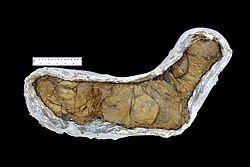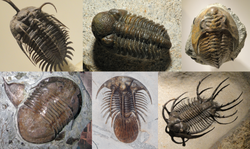dictionary. A trace fossil, also called an ichnofossil (/ˈɪknoʊˌfɒsɪl/; from Ancient Greek ἴχνος (íkhnos) 'trace, track'), is a fossil record of biological...
48 KB (5,453 words) - 21:09, 18 July 2025
Trace fossils are classified in various ways for different purposes. Traces can be classified taxonomically (by morphology), ethologically (by behavior)...
13 KB (1,575 words) - 09:02, 25 May 2025
Paleontology (redirect from Fossil taxon)
paleontology can be traced back to the mythologies of indigenous peoples of many continents and the interpretation of discovered fossils as the bones of dragons...
101 KB (12,914 words) - 08:45, 1 July 2025
A fossil (from Classical Latin fossilis, lit. 'obtained by digging') is any preserved remains, impression, or trace of any once-living thing from a past...
112 KB (11,549 words) - 22:09, 17 July 2025
Paleodictyon (category Burrow fossils)
Paleodictyon is a trace fossil, usually interpreted to be a burrow, which appears in the geologic marine record beginning in the Precambrian/Early Cambrian...
8 KB (907 words) - 21:18, 9 June 2025
fossil track or ichnite (Greek "ιχνιον" (ichnion) – a track, trace or footstep) is a fossilized footprint. This is a type of trace fossil. A fossil trackway...
27 KB (2,958 words) - 08:54, 17 July 2025
Cambrian explosion (section Trace fossils)
unknown. Trace fossils consist mainly of tracks and burrows, but also include coprolites (fossil feces) and marks left by feeding. Trace fossils are particularly...
135 KB (15,490 words) - 16:08, 18 July 2025
Paleodictyon nodosum (category Burrow fossils)
The hypothesis supported by Seilacher, that the burrows we find are trace fossils of a worm-like animal, is supported by several features of the burrows...
10 KB (1,238 words) - 21:15, 9 June 2025
Ichnotaxon (redirect from Daedalus (trace fossil))
chaotic nature of trace fossil classification, several ichnogenera hold names normally affiliated with animal body fossils or plant fossils. For example,...
4 KB (416 words) - 17:08, 13 April 2025
Coprolite (redirect from Fossil shit)
coprolith) is fossilized feces. Coprolites are classified as trace fossils as opposed to body fossils, as they give evidence for the animal's behaviour (in this...
15 KB (1,488 words) - 08:48, 1 July 2025
evaporates are usually associated with gastropod, algae, vertebrate, and trace fossils. Fossils are not to be found in areas of igneous rock (except in some beds...
20 KB (2,158 words) - 11:10, 25 May 2025
study the smoothness of trace fossils from the Ediacaran–Cambrian transition, and link the appearance of smooth trace fossils during the latest Ediacaran...
234 KB (20,348 words) - 16:29, 19 July 2025
Trilobite (section Fossil record of early trilobites)
as trace fossils. There are three main forms of trace fossils associated with trilobites: Rusophycus, Cruziana and Diplichnites—such trace fossils represent...
119 KB (12,571 words) - 16:21, 14 July 2025
отложений Восточно-Европейской платформы" [Soft-bodied Metazoa and trace fossils of Vendian and Lower Cambrian: In Upper Precambrian and Cambrian Paleontology...
92 KB (5,609 words) - 21:40, 8 July 2025
Ediacaran biota (redirect from Ediacaran fossils)
were enigmatic tubular and frond-shaped, mostly sessile, organisms. Trace fossils of these organisms have been found worldwide, and represent the earliest...
109 KB (11,348 words) - 01:07, 12 July 2025
Conostichus (category Burrow fossils)
Conostichus is an ichnogenus of cnidarian trace fossil. They are nowadays considered to represent a burrow structure serving as a holdfast for an anemone-like...
5 KB (465 words) - 21:32, 26 May 2025
Because burrow fossils represent the preserved byproducts of behavior rather than physical remains, they are considered a kind of trace fossil. One common...
2 KB (196 words) - 02:31, 20 January 2025
fossils (also known as guide fossils or indicator fossils) are fossils used to define and identify geologic periods (or faunal stages). Index fossils...
3 KB (85 words) - 16:11, 8 June 2025
Look up Trace, trace, traces, or tracing in Wiktionary, the free dictionary. Trace may refer to: Trace (Son Volt album), 1995 Trace (Died Pretty album)...
5 KB (596 words) - 15:11, 12 June 2025
The history of paleontology traces the history of the effort to understand the history of life on Earth by studying the fossil record left behind by living...
65 KB (8,445 words) - 08:58, 1 July 2025
Skolithos (category Burrow fossils)
Skolithos (formerly spelled Scolithus or Skolithus) is a common trace fossil ichnogenus that is, or was originally, an approximately vertical cylindrical...
14 KB (1,687 words) - 21:52, 5 April 2025
Treptichnus (category Trace fossil stubs)
an animal. As such, it is regarded as the earliest widespread complex trace fossil. Its earliest appearance, around 542 million years ago (mya), which was...
5 KB (470 words) - 21:10, 14 January 2025
Amber (redirect from Fossil amber)
Romance languages, the sense of the word was extended to Baltic amber (fossil resin) from as early as the late 13th century. At first called white or...
61 KB (6,760 words) - 14:35, 9 July 2025
Biostratigraphy (redirect from Index Fossil)
the section. Index fossils (also known as guide fossils, indicator fossils, or dating fossils) are the fossilized remains or traces of particular plants...
13 KB (1,664 words) - 23:04, 16 July 2025
Paleobotany (redirect from Plant fossil)
branch of botany dealing with the recovery and identification of plant fossils from geological contexts, and their use for the biological reconstruction...
28 KB (2,951 words) - 18:38, 24 May 2025
history of life. In this scientific quest, macrofossils, microfossils and trace fossils are typically analyzed. However, the 21st-century biochemical analysis...
15 KB (1,874 words) - 03:22, 16 April 2025
Epibaion (category Fossil taxa described in 2002)
Epibaion is a trace fossil imprint of the Ediacaran animals of the phylum Proarticulata, which became extinct in the Precambrian. Imprints often occurring...
2 KB (178 words) - 01:39, 9 November 2021
Pholad borings (category Trace fossil stubs)
interior. Ancient, sand-filled pholad borings are a distinctive type of trace fossil known as Gastrochaenolites that are found in some limestones, dolomites...
4 KB (416 words) - 14:08, 24 September 2023
October 1998). "Triploblastic animals more than 1 billion years ago: trace fossil evidence from india". Science. 282 (5386): 80–83. Bibcode:1998Sci...282...
119 KB (10,517 words) - 16:24, 19 July 2025
Borden Formation (section Trace fossils)
Formation at mile marker 135, I-64, Kentucky Another Zoophycos trace fossil from Kentucky Trace fossils in sandstone (Henley Member) There are three members of...
14 KB (1,035 words) - 18:56, 1 July 2025






















